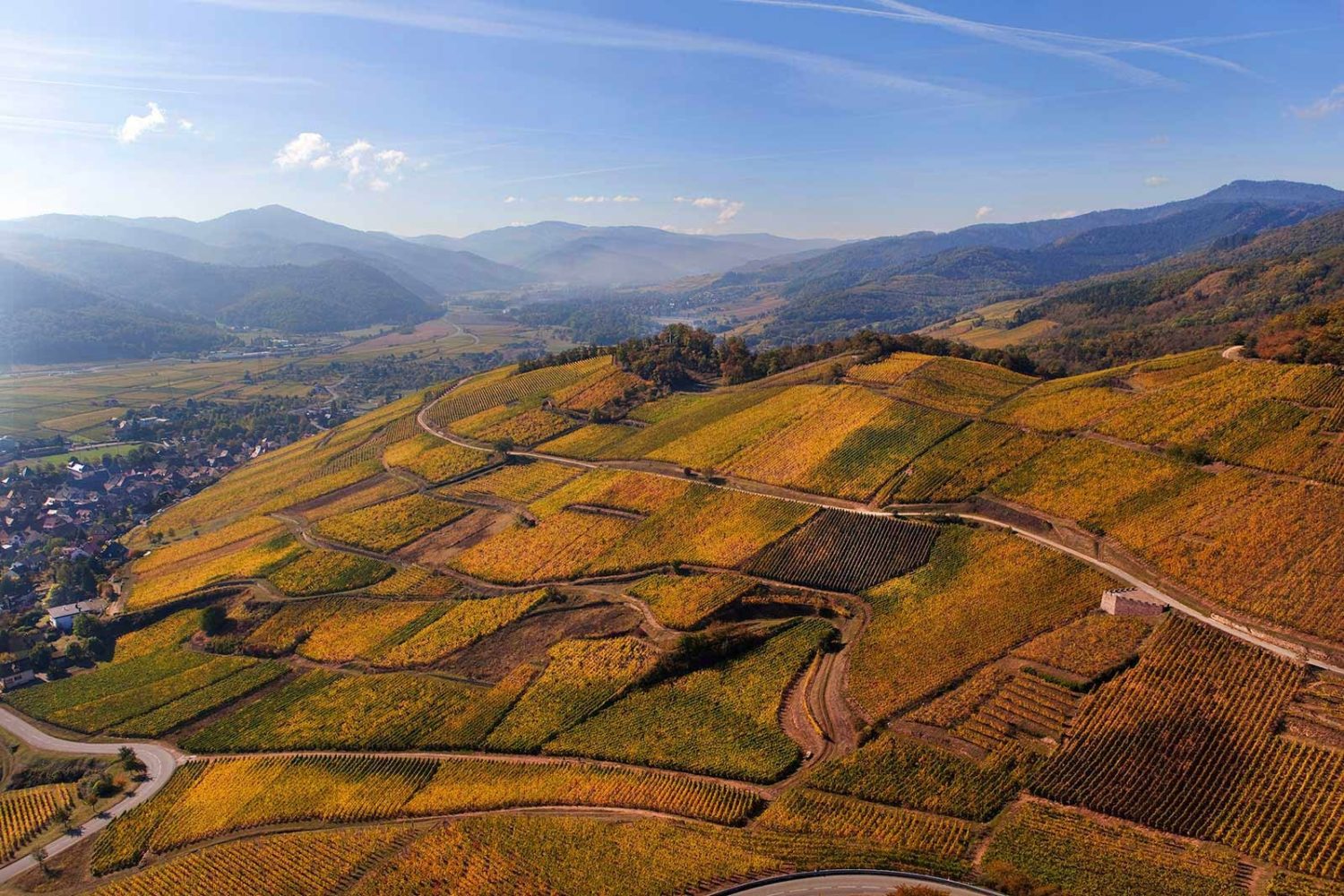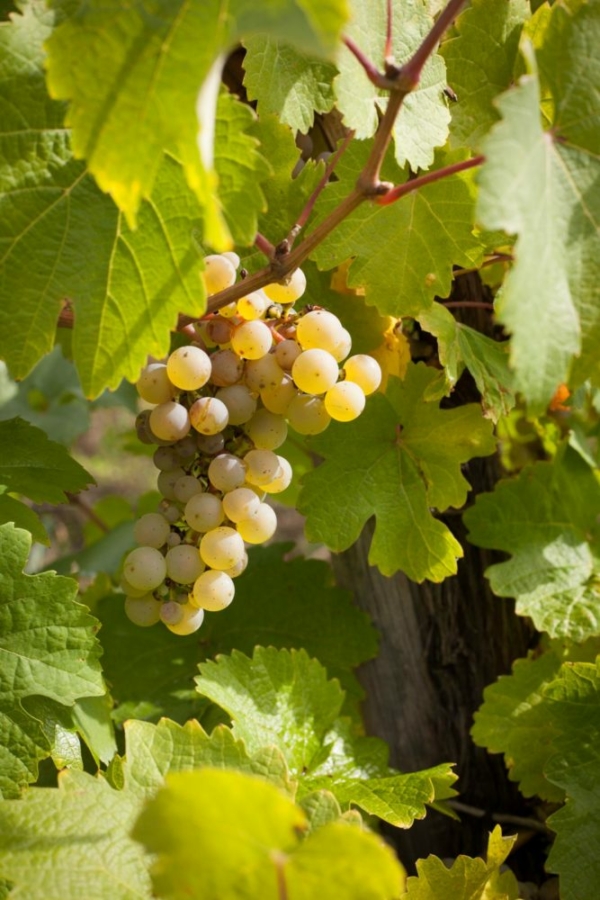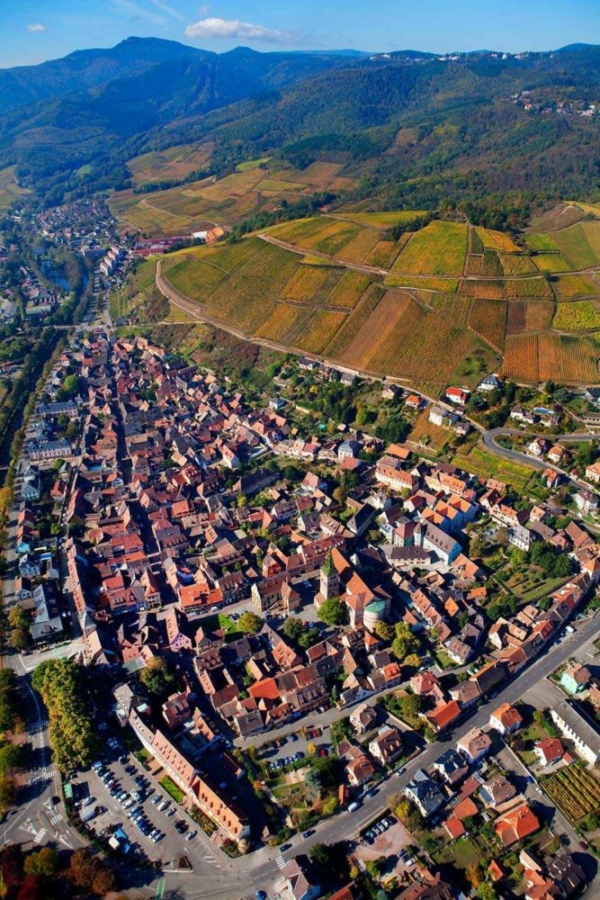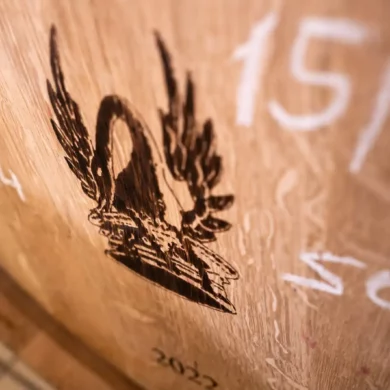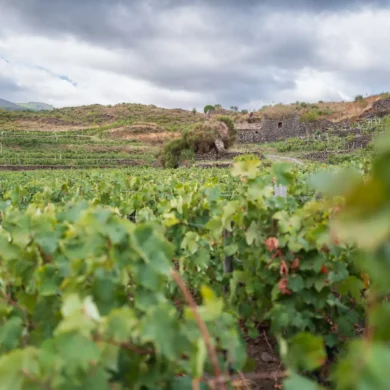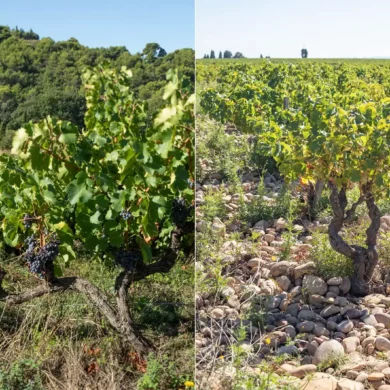Perhaps no one described wine better than Galileo Galilei when he asserted “wine is sunlight, held together by water.” Being from Pisa, I doubt he was describing Riesling — let alone one from Alsace — but I cannot think of a wine that matches his quote any better. Alsatian Rieslings are a pure delight: ripe, racy, honeyed, full-bodied and bright. It would seem as though they derive their powers straight from the sun as Galileo mused.
That’s because they do. Alsace is among France’s sunniest and driest climates, and the vines of Riesling here ripen with precision for a balanced, dry white wine that endures for years.
Like in Burgundy, the best sites are deemed Grand Cru and clearly delineated and regulated as such. One vineyard in particular has caught my eye in recent tastings: the Grand Cru Brand which looms over the village of Turckheim. So far this year, the very best white wine I’ve sampled is a nine-year-old dry Riesling from this vineyard. A younger version from a legendary producer is a very close second. (See tasting notes below).
So what makes the Grand Cru Brand so enticing? It’s a complicated mix of soil, aspect to the sun, meticulous producers and a condemned dragon.
Dirt Smoothie
Beneath the Alsatian landscape of storybook villages and tidy vineyards lies complete disorder. Here, 13 different soil types commingle to create one of the most complicated geologic stories in the wine world. From a distance, subterranean Alsace sounds like a dish with too many ingredients, but generations of winemakers have figured it out. Ask an Alsatian winemaker to describe a vineyard’s terroir, and you may suddenly feel as though you are pursuing a graduate’s degree in geology.
“The Grand Cru Brand is located on one of the oldest soils in Alsace, a pink biotite granite with two micas, ” Jolene Hunter told me. She is the former Assistant Winemaker at Domaine Zind-Humbrecht, and now, she oversees their exports.
My head often swims when rock talk comes about in wine circles, but for some reason, with Riesling, I get it. I may not be able to identify granite versus limestone attributes blind, but I can certainly sense something is going on with the wine’s texture. Riesling is always honest about its dirt.
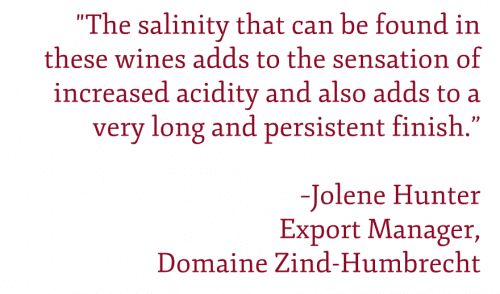
The granite soil composite that Jolene referred to — known as Steinglitz locally — defines the Grand Cru Brand, even though some parcels near the base of the hill have more limestone content.
Jolene went on to tell me that the granite bedrock had eroded over millions of years and “yielded very interesting clay minerals” which she believes, lends a quality of minerality to the Grand Cru Brand wines.
Take a sip of a Grand Cru Brand Riesling and you will notice its lovely texture. It hangs around. It is playful, and it whispers long after you’ve swallowed. The sensation has nothing to do with fruit. To me, that’s where the magic resides with these wines.
Thierry Fritsch, a resident expert with Wines of Alsace, noted to me that Grand Cru Brand wines have a saline quality to them as well. “The Riesling wines have a rich structure, but are dry,” he told me. “By rich, I mean with a lot of minerality and sometimes (they are) ‘salted.'”
He attributes this not only to the broken granite, mica and clay minerals in the soil, but also the high levels of micronutrients, which give these Riesling wines an extra kick.
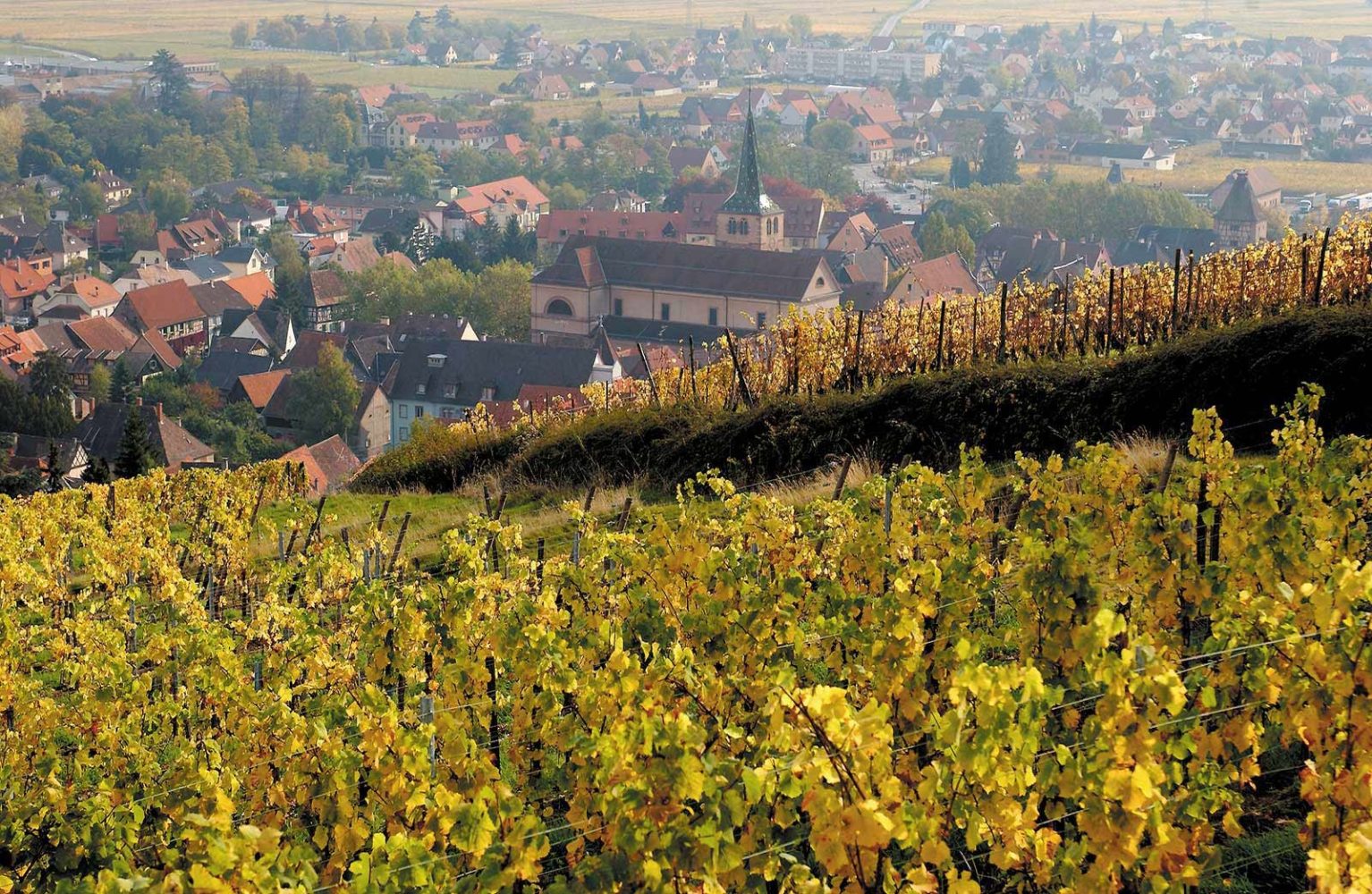
Jolene agrees. For a comparison, she suggests looking at the Brand through the lens of other Grand Cru sites that are predominantly limestone. “The (wine from) Brand … has a slightly higher pH compared to the wines from limestone soils,” she notes. “The salinity that can be found in these wines adds to the sensation of increased acidity and also adds to a very long and persistent finish.”
The Brand’s Microclimate
The Grand Cru Brand’s unique attributes also stem from the sky. It is one of the driest vineyards in Alsace thanks to a rain shadow from the Vosge Mountains, and persistent westerly winds tussle the vines, a factor that leads to more concentration of flavors in the berries.
But if this sounds like a miracle plot of land where happy clusters of Riesling easily yield world-class wines each year, think again.
“The Brand terroir is precocious,” Jolene told me. “The picking date is extremely important. The potential alcohol can increase and total acidity levels drop very quickly in this terroir … The optimal window for picking the Brand is very small.”
To solve this, the team at Domaine Zind-Humbrecht harvests according to vine age, using the older vines (between 60 and 65 years of age) for the Grand Cru Brand bottling, and the younger vines (30 to 35 years of age) for a separate bottling called Roche Granitique.
“In certain vintages the effects of the deeper, better-established root system of the older vines helps to resist against climatic consequences such as hydric stress,” Jolene says.
She also notes that farming with biodynamic principles seems to lead to earlier ripening. This allows them to pick the grapes at a lower potential alcohol without sacrificing the ripe fruit that gives Riesling its sunny — yet never saccharine — character.
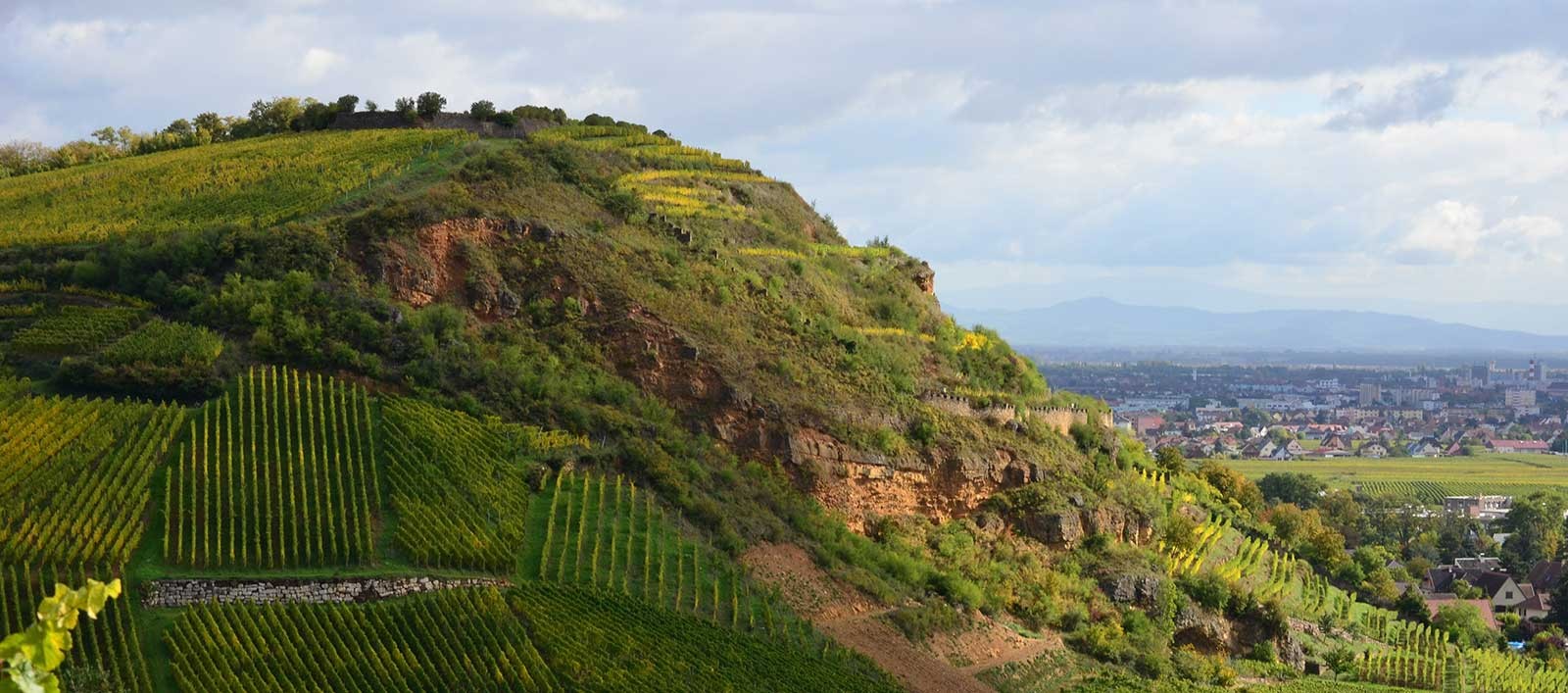
An Inferno Vineyard
So what’s with this dragon fellow?
Well, local legend has it that a woeful dragon fought the sun on the ground of Grand Cru Brand (which in German translates as “fire”). I am not sure how you fight a ball of fire that is 109 times the size of Earth, but naturally, the dragon lost. Despairing in defeat, he was banished underground and that’s why — there is always a “that’s why” in local legends — the ground of Grand Cru Brand radiates heat in the summertime. (Not, for the record, because a 10,000º F orb touched down here).
In truth, that warmth comes from the Grand Cru Brand’s reflective soil and the hillside’s sun-tanning angle to the sky. This combination amplifies the warm days and keeps the summer heat lingering well into the evening each day, a final element to the vineyard’s complicated terroir.
Time to Drink from the Fire
Riesling accounts for just 41% of the vineyard, but it is far and away the lead actor in the Grand Cru Brand’s story, and the most likely wine you will find on your wine shop’s shelf. But there is also Pinot Gris, Gewürztraminer and Muscat. “Pinot Gris shows nearly the same profile (as Riesling),” Thierry told me. “I’m always surprised by the Gewurztraminer produced there, too. If the wines are rich, they’re really spicy … due to the warm climate and the balance is done by the bitterness.”
There is even a rare Pinot Noir made from the Grand Cru Brand, which is surprising given the vineyard’s heat and granite soils — two thing Pinot Noir has always despised.
By law, blends are not allowed to claim Grand Cru status, so vignerons focus solely on the Grand Cru Brand’s presentation of varietal character. In off-vintages — or with plots where the vines are younger — they may utilize some of the grapes for a broader blend, but with vineyard land this good, the emphasis will always be on producing the finest single varietal you can.
To immerse yourself in the wines of this extraordinary vineyard, I’ve selected two wines — one with some age, another with a little youth. They both earn my highest rating, particularly because of their texture and their versatility with cuisine. If I had to choose one, it would be the François Baur, but only because of the added dimension its age offers.
Looking into a crystal ball is always problematic for a wine writer, but I would imagine that the Domaine Zind-Humbrecht version — at nine years of age — would be equally stunning. Its freshness and the way the wine held together for a few days after being opened, suggest that the Riesling from Domaine Zind-Humbrecht’s parcels can go a significant distance in the cellar.
But with spring in the air and sunshine on your shoulders, why wait?
2009 Domaine François Baur Grand Cru Brand Riesling
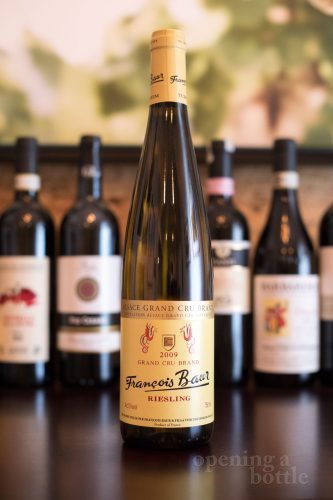 Grand Cru Brand AOC (Alsace AOC)
Grand Cru Brand AOC (Alsace AOC)
Grapes: Riesling (100%)
Alcohol: 13%
Ratings: ★★★★★ (out of five)
Food-friendliness: Impeccable
Value: Very Good
Tasting notes: In a word: exceptional. Probably one of the very best Rieslings I have ever tasted. The aromas brought forth recollections that were both intense and unmistakable: sliced golden apples, pear skin, clover honey, springtime flowers and lemon oil. At times, I also picked up a note reminiscent of brown sugar, usually on the finish. On the palate, the delicate sweetness was precisely countered by a lime pith-like acidity. An almost glycerin texture. The finish was broad, and long and worth savoring. Amazing freshness for its nine years of age.
Serving suggestion: Be careful not to overchill this wines, and if you do, let it warm back up to release those complex and compelling aromas. Simple delight: pair it with an aged sharp cheese. Have more time? Roast a pork loin and see what happens.
Find a Bottle of Domaine François Baur Grand Cru Brand Riesling
2014 Domaine Zind-Humbrecht Grand Cru Brand Riesling
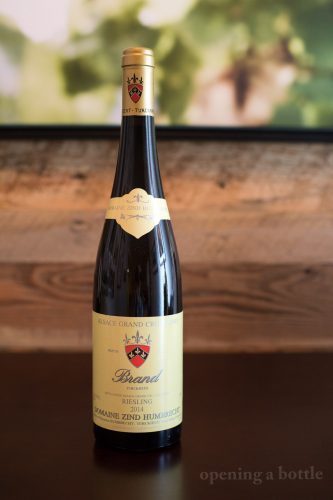 Grand Cru Brand (Alsace AOC)
Grand Cru Brand (Alsace AOC)
Grapes: Riesling (100%)
Alcohol: 12.5%
Ratings: ★★★★★ (out of five)
• Food-friendliness: Impeccable
• Value: As Expected
Tasting notes: Sublime. Quite possibly the apex of dry Riesling. Although, when compared to the 2009 François Baur from the same vineyard, it feels a little young, as though it may develop even more complexity with time. Beautiful golden color. Vivacious aromas recalling white peach, honey, melon, pear skin and a touch of creme brûlée with lime-citrus acidity. Less floral than François Baur, more ripe in its fruit. Offers that wonderful sleight-of-hand trick that the best dry Rieslings show — an illusion of sweetness without the sensation of sugar.
Serving suggestion: Sushi, particularly unagi with a thin slice of ginger or a dragon roll. On the second night, we served it with a Moroccan-spiced barley dish and once again it was an exceptional supporting cast member. If you want to enjoy its full aromas, chill, but remove from the refrigerator about 45 minutes before serving.
Find a Bottle of Domaine Zind-Humbrecht Grand Cru Brand Riesling
Two Other Grand Cru Riesling from Alsace to Try
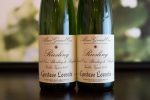 These aren’t the only Grand Cru Riesling you should be seeking out. Far from it. Learn more about two others.
These aren’t the only Grand Cru Riesling you should be seeking out. Far from it. Learn more about two others.

